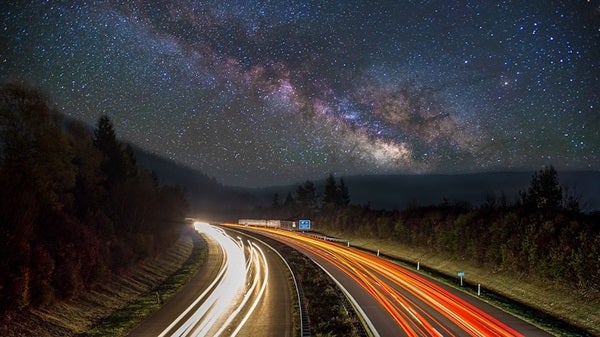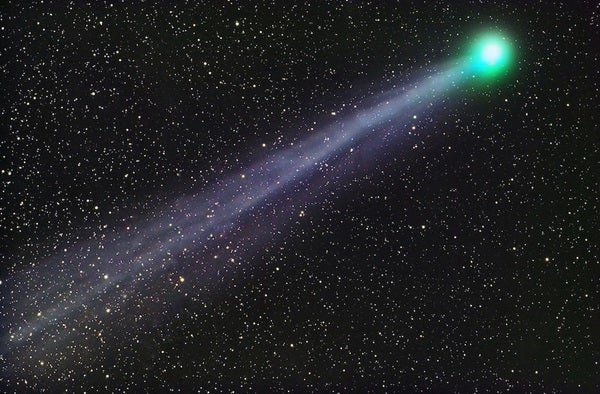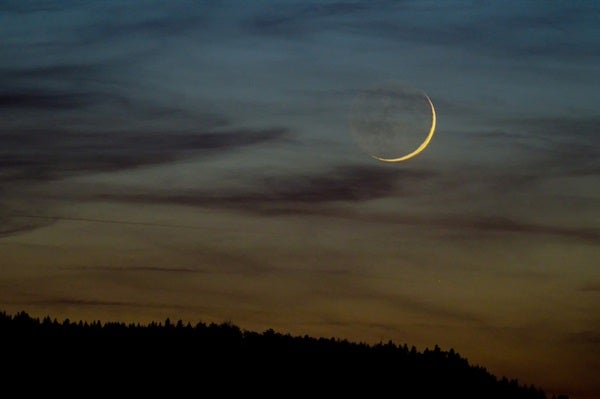Friday, June 8
Venus dominates the western sky after sunset. The dazzling object shines at magnitude –4.0 among the background stars of eastern Gemini. The planet appears 16° high an hour after sunset, a fraction of a degree lower than it was at its peak last week. This evening, Venus passes 5° due south (lower left) of Gemini’s luminary, 1st-magnitude Pollux. The planet shines 100 times brighter than the star. When viewed through a telescope, Venus appears 14″ across and about three-quarters lit.
Saturday, June 9
Another comet in the growing crowd of such objects discovered by the Pan-STARRS telescope in Hawaii makes its appearance in June’s morning sky. Comet PANSTARRS (C/2016 M1) currently glows around 9th magnitude within the Teapot asterism of the constellation Sagittarius, and you’ll need a telescope to spot its subtle glow. As a bonus both today and tomorrow, the comet slides about 40′ from the 8th-magnitude globular star cluster M54. Your best views will come from under a dark sky when Sagittarius climbs highest between 2 and 3 a.m. local daylight time.
Sunday, June 10
Look high in the northwest after darkness falls this month, and you will see the familiar sight of the Big Dipper. The Dipper is the most conspicuous asterism — a recognizable pattern of stars that doesn’t form a complete constellation shape — in the entire sky. It forms the body and tail of Ursa Major the Great Bear. Use the Pointers, the two stars at the end of the Dipper’s bowl, to find Polaris, which lies due north for everyone north of the equator. Polaris marks the end of the Little Dipper’s handle. On June evenings, the relatively faint stars of this dipper arc directly above Polaris.
Monday, June 11
Venus appears 6° to the left of Gemini’s brightest star, Pollux, this evening. The Twins’ second-brightest star, Castor, lies 4.5° to Castor’s right. The three objects make a fine sight in the western sky from about an hour after sunset until they set around 11 p.m. local daylight time. Although Venus appears near Gemini’s brightest stars, it actually crosses into neighboring Cancer the Crab today.
Tuesday, June 12
Mars rises shortly before midnight local daylight time and climbs nearly 30° high in the south by the time morning twilight commences. Although it is still a month and a half away from its late July opposition, the Red Planet appears noticeably brighter than it did just a week ago. Shining at magnitude –1.6, it is the third-brightest point of light in the night sky after Venus and Jupiter. If you point a telescope toward Mars this morning, you’ll see a 17″-diameter disk that sports several subtle surface features.
Wednesday, June 13
Although Saturn will reach opposition and peak visibility two weeks from today, observers will be hard-pressed to see it as inferior this week. The ringed planet rises shortly after 9 p.m. local daylight time and appears highest in the south around 2 a.m. Saturn shines at magnitude 0.1 and stands out against the background stars of northern Sagittarius. If you target the planet through binoculars this week, you’ll find it 2.4° northwest of the 5th-magnitude globular star cluster M22 and 3.4° south of the similarly bright open cluster M25. But the beautiful world looks best through a telescope, which reveals its 18″-diameter disk and a stunning ring system that spans 42″ and tilts 26° to our line of sight.
New Moon occurs at 3:43 p.m. EDT. At its New phase, the Moon crosses the sky with the Sun and so remains hidden in our star’s glare.
Thursday, June 14
For people who live near 40° north latitude, today marks the earliest sunrise of the year. Although the Northern Hemisphere’s longest day doesn’t occur until Earth’s summer solstice a week from today, earliest sunrise happens several days before and latest sunset several days after. The specific dates depend on your latitude, however — earliest sunrise at 30° north came on the 11th. In general, earliest sunrise occurs closer to the solstice the farther north you live.
The Moon reaches perigee, the closest point in its orbit around Earth, at 7:53 p.m. EDT. It then lies 223,385 miles (359,503 kilometers) away from us.
Friday, June 15
Dwarf planet 1 Ceres is the largest object in the asteroid belt, which lies between the orbits of Mars and Jupiter. It currently resides within the Sickle asterism in western Leo, which appears 25° high in the west after twilight fades to darkness. The magnitude 8.7 dwarf planet is easy to spot through binoculars or a telescope, particularly this evening when it appears less than 0.1° from the 6th-magnitude star SAO 81154. Point your scope at this star, and Ceres will be the brightest object in its immediate vicinity.
Saturday, June 16
The waxing crescent Moon stands 8° to the upper left of Venus this evening. If you wait for the sky to grow dark and use binoculars to enjoy the scene, you should notice the superb Beehive star cluster (M44) midway between the planet and the Moon.
Sunday, June 17
Jupiter reached opposition and peak visibility in early May, but it remains a stunning sight from evening twilight until it sets around 3 a.m. local daylight time. The giant planet appears best when it climbs highest in the south around 10 p.m. Jupiter shines at magnitude –2.4 and is the night sky’s brightest point of light once Venus sets around 11 p.m. The gas giant resides among the background stars of Libra the Scales, 1.5° northwest of Zubenelgenubi (Alpha [a] Librae). If you view the planet through a telescope tonight, its disk spans 43″ and displays spectacular cloud-top detail.












